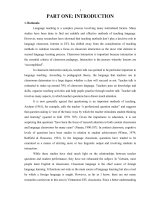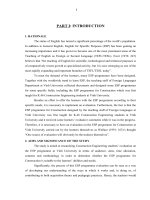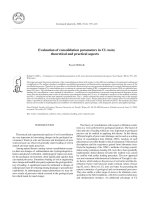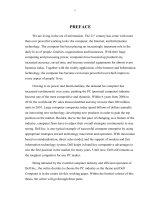Evaluation Adidas strategies
Bạn đang xem bản rút gọn của tài liệu. Xem và tải ngay bản đầy đủ của tài liệu tại đây (336.1 KB, 18 trang )
Evaluation of ADIDAS
AG’s Strategy
Team: The Smurfs
1. Nguyen Thy Ngoc Dung
2. Huỳnh Thi My Dieu
3. Nguyen Thi Thuan
4. Le Thanh Tam
5. Huynh Thi Doan Thuy
1
Introduction- History
•
1949: Founding Father
•
1971: Out of the trunk, into the world – The birth of
Rockport
•
1972: The TREFOIL and the Olympic idea
•
1978: Death of a shoemaker
•
1987: End of the family business
•
1993: A sleeping giant’s new master
•
2001: An Innovative leader
2
Introduction-History
•
(2000s): New century, new divisions
•
2004: Impossible ? Just a big word . Slogan:
IMPOSSIBLE IS NOTHING
•
2006: Salomon leaves the team, Reebok joined the
family
•
2013: Endless innovation
•
TODAY: Welcome to the new world_ A new digital
focus.
3
STRATEGIC PILLARS
•
Diverse brand portfolio
•
Investments focused on highest- potential
markets and channels
•
Creating a flexible supply chain
•
Leading through innovation
•
Develop a team grounded in our heritage
•
Becoming a sustainable company
4
Adidas’ Business
Perfor mance
•
In 2013, Adidas group revenues decreased 3% to € 14,492
billion from € 14,883 billion in 2012.
•
The Group’s gross margin increase 1.5 percentage point
to 49.3% (2012: 47.7%)
•
The Group’s gross profit rose 1% to € 7,140 billion versus
€ 7,103 billion in 2012.
•
In 2013, the Adidas Group incurred goodwill impairment
looses of € 52 million (2012: € 265 million).
5
[Source: Annual Report 2013]
Adidas’ Business
Perfor mance
•
The Group’s operating profit grew 6% to € 1,254 billion compared to €
1,185 billion in 2012, representing an operating margin of 8.7%, up 0.7
percentage point.
•
Net income attributable to shareholders excluding goodwill
impairment losses was up to 6% to € 839 million (2012: € 791 million).
•
Basic and diluted earnings per share excluding goodwill impairment
losses grew 6% to € 4.01 from € 3.78 in 2012.
•
At the end of December 2013, the Group employed 50,728 people (in
2012: 46,306), up to 10%
6
[Source: Annual Report 2013]
Adidas’ Business
Perfor mance by
Segment
7
Wholesale:
[Source: Annual Report 2013]
Adidas’ Business
Perfor mance by
Segment
Retail:
8
At the end of December 2013, the Adidas Group Retail segment operated 2,740
stores (increased 294 stores or 12% versus 2012: 2,446 stores). Of the total number
of stores, 1,557 were Adidas and 404 were Reebok branded.
[Source: Annual Report 2013]
Adidas’ Business
Perfor mance by
Segment
Other Business:
9
[Source: Annual Report 2013]
adidas’
Strategic
evaluation
- Global Sales aims to drive the commercial performance of the Adidas Group by building
brand desire, meeting consumer needs at all times and capturing additional consumer
potential.
- Adidas recovery driven by product and retail development. Like rival Nike, Adidas
develop sales in mature markets. The company reported that currency neutral sales in
Western Europe, a region that continues to face significant economic pressure.
- Two brands underpin segment and retail strength. The wholesale and retail segments
comprise the Adidas and Reebok brands, the other brands, including Rockport and
TaylorMade. The company is developing different brand strategies for each of these.
10
[Source: Annual Report 2013]
Adidas’ Strategic
evaluation
11
[Source: Annual Report 2013]
-
Controlling the brand in the retail space. The company has distributed its
products through third party retail accounts, principally footwear, sporting
goods and department stores. Other sports brands including Nike and Puma
have followed this strategy. At least open 550 stores, grow to € 500 million in
2015.
-
Social media use supports brand proposition. Adidas is looking to strengthen
its relationship with consumers by increasing its use of social media. Adidas
slightly lags behind its principal rival Nike in this strategy .
-
Biggest brands lead global charge. These strategies have underpinned global
awareness, and made the Adidas brand the principal tool for expansion.
-
Multi brand strategy allows numerous positions. This lets Adidas target the
widest possible group of consumers, without compromising the perceived
core competency and position of a particular brand.
Adidas’ strategic
business plan 2015
12
[Source: Annual Report 2013]
•
Based on our strong brands, premium products, extensive global presence
and commit to innovation and the summer, Adidas aspire to grow business
significantly in the five year period from 2010 to 2015. Adidas’s financial
aspirations include increasing Group Sale to €17 billion achieving an
operating margin of 11% and increasing annual earnings at a compound
annual rate of 15%.
•
Sales growth implies outperforming total market growth, both GDP and the
sporting goods industry. Adidas three key “attack markets” North America,
Greater China and Russia/CIS are targeted to contribute around 50% of
total Group sales growth. We intend to increase the portion of sales
generated through controlled space initiatives to over 50% of Group sales in
the coming years.
ADIDAS Opportunities
•
Adidas has sponsorship agreements for major sports
events (Japan Football Association, Australian Olympic
Committee, UEFA Champions League, FIFA World Cup…)
helps the company strengthen its profitability and
enhance its brand recall among consumers.
•
Tie-up with emerging sports teams/clubs/players
internationally.
•
Adidas can strengthen the relationship between brand
and consumer with e-commerce, social media and
smartphone apps
ADIDAS Threats
•
All sports brands of Adidas suffer from large
amounts of fake products => decrease company
revenue and brand image.
•
Other brands (PUMA, NIKE…) offer more styles and
varieties, thus more competition.
•
The ability of newly-developed economies (Ex:
China) to produce similar products at lower prices,
which puts pressure on Adidas to lower its costs in
order to maintain market share
Strategic objectives and challenges
•
Product development
–
Adidas consumers expect a constant stream of innovation and design updates.
This will be a constant challenge for the company going forward, especially as it
expands into new markets
•
Managing production costs
–
Rising costs has been a challenge for all apparel producers, and will continue to
be so in future. The issue has taken a significant share out of Adidas’ gross
margins, and managing this in future will be extremely challenging.
•
Multi brand, multi position
–
Adidas‘ operation of a variety of brands gives it a competitive edge, allowing it
to appeal to a broader consumer base audience than many of its competitors.
Further acquisitions could significantly boost sales, especially in areas where the
company has identified growth such as outdoor or adventure sports.
RECOMMENDATION
•
ADIDAS WILL FOCUS ON THE STATEMENT: BE IT PRODUCTS, BE IT CAMPAIGNS, BE IT
IMAGINATION.
•
Build up the brand with the football, basketball event :
–
Adidas will be the Official Partner of the FIFA World Cup to be the visible brand
during the event. Their products will come along with the tournament and increase
the sales.
–
Adidas will leverage their on-court visibility through NBA players such as Derrick
Rose, Jeremy Lin, Dwight Howard, Damian Lillard…
•
Focus on the Expansion of the highly successful Boost franchise
•
Adidas introduce there new stores concept called “Neighbourhood”, which roll out to
over 30 cities in next few years, and focus on new collaborations with premium retailers
such as Topshop, Urban outfitters and Farm.
•
Adidas will leverage their strategic collaboration with pop icons and celebrities such as
Alicia Keys, Shaq O’Neal and Tyga
16
CONCLUSION
•
Adidas is a growth company, they grow in all
market, all channels and all brands.
•
This is the result of the right strategies of Adidas
to focus on the right customers and the way to
image their brand.
•
Their passion is loving sport and they will
continue to follow the vision of the Group – to be
the leading sporting goods company in the world.
17
18









